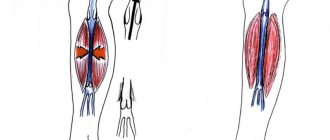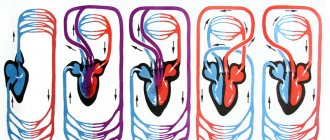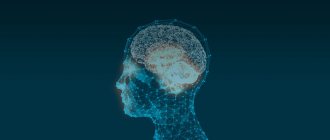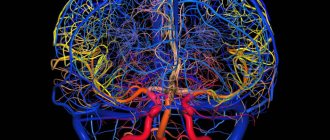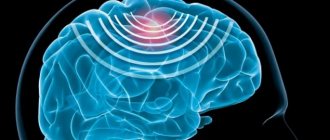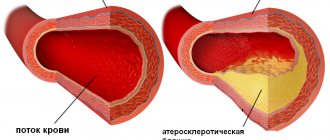December 12, 2013
The extensive network of the human circulatory system consists not only of large veins and arteries, but also of the smallest capillaries
The extensive network of the human circulatory system consists not only of large veins and arteries, but also of the smallest capillaries, thanks to which all the substances necessary for optimal life are delivered to each of our cells along with blood. It is not surprising that a person’s health largely depends on the state of his cardiovascular system.
Foundation of life
The circulatory system consists of more than just the heart, blood, and blood vessels. This is only one of two complementary systems - cardiovascular and lymphatic. The latter serves to transport lymph - a colorless liquid with many lymphocytes. The lymphatic system is also extremely important, because human immunity largely depends on it. It is these two systems - cardiovascular and lymphatic - that make up the largest human circulatory system with a total length of more than 100,000 km. This complex mechanism is driven by the heart. This living motor, consisting of muscles, works with amazing performance, pumping more than 9,500 liters of blood per day. In this way, blood is supplied to every cell.
Blood swirls
Followers of the “ancient teacher” Galen believed that the arteries contain little blood and a lot of air, while the veins are filled with blood. It would seem, where did this belief come from? After all, with any injury that affects an artery, blood flows! This has been known since ancient times, and was also observed during ancient sacrifices. But doctors had a different picture. They relied on data obtained from autopsies. And in a dead body, the arteries are bloodless, while the veins are full. And this picture prevented a correct understanding of the problem. Therefore, nothing was known about blood circulation. It was believed that blood was formed in the liver and from there through the greater vena cava it entered the heart.
William Harvey. Photo: Commons.wikimedia.org
Known for his skepticism even in his student years, Harvey wrote: “When I first turned all my thoughts and desires to observations based on vivisections (to the extent that I had to do them), so that through my own contemplations, and not from books and manuscripts, to recognize the meaning and benefits of cardiac movements in living beings, I discovered that this question is very complex and full of mysteries at every step.” The scientist came to his conclusion through numerous experiments, when he studied the still beating hearts and lungs of dissected animals.
Harvey made this great discovery in 1616, when he said in one of his lectures that “the blood circles in the body.” However, for many years he continued to search and accumulate evidence. And only twelve years later he finally published the results of his work: “Anatomical studies on the movement of the heart and blood of animals.”
Accusations of vivisection - experiments involving the dissection of living animals - continue to haunt his reputation to this day. However, everything he did, he did for the sake of science. The burning candle on William Harvey's coat of arms symbolized "life consumed by flame, yet luminous."
One chance in a hundred. Who was saved by the first blood transfusion? More details
Main functions of the system
The work of the circulatory system begins with the enrichment of blood with oxygen. “Depleted” blood enters the heart through the veins: first into the first chamber of the right atrium, then into the right ventricle of the heart. From there, the more powerful heart muscles push oxygen-deprived blood into the pulmonary trunk, divided into two pulmonary arteries. Next, the blood enters the lungs through numerous pulmonary vessels, where it is enriched with oxygen and returns through the pulmonary vessels to the heart - but this time to the left atrium and ventricle. The left ventricle of the heart is responsible for supplying blood to the entire body, therefore, the muscles of the left ventricle are more developed. Human blood circulation consists of two circles: small (pulmonary) and large. The small circle is responsible for enriching the blood with oxygen, and the large circle is responsible for transporting blood throughout the body. Despite the fact that two atria and two ventricles contract simultaneously, the thick-walled left ventricle experiences a load six times greater, because it has to circulate blood in a large circle, supplying all limbs with useful substances.
Mister Diafuarus
“He is firm in argument, unshakable in his views, never changes his judgments ... he blindly believes our ancient teachers and does not even want to hear about the so-called discoveries of our century regarding blood circulation and the like.” of Moliere’s “The Imaginary Invalid”, Doctor Diafuarus, praised the virtues of a doctor It was precisely this position that the outstanding researcher of the human body, William Harvey (1578–1657), had to face when he first published his essay on the movement of the heart and blood.
Article on the topic How does the human circulatory system work? Infographics
The scientist had to come to grips with the then dominant traditional view, based on the teachings of the great physician of Antiquity, Galen . The passionate and heated discussion about blood circulation went far beyond the circle of specialists. The Paris Faculty of Medicine, whose professors unwaveringly adhered to the teachings of Galen, declared real war on Harvey.
What harms blood vessels?
The scourge of modern man is the deposits of fat on the walls of blood arteries (mainly “bad” cholesterol), as a result of which atherosclerotic changes in blood vessels occur. Fat accumulations form atheromas and cholesterol plaques on the walls of blood vessels, which narrow the patency of blood vessels and impair blood flow. The heart has to work harder, which leads to its premature aging, while little oxygenated blood reaches the tissues. As a result, the body faces the threat of oxygen starvation.
Functions of the human circulatory system
The main role played by the cardiovascular system in the human body is to move blood from the heart to other internal organs and tissues and back. Many processes depend on this, thanks to which it is possible to maintain normal life activity:
- cellular respiration, that is, the transfer of oxygen from the lungs to tissues with subsequent utilization of waste carbon dioxide;
- nutrition of tissues and cells with substances contained in the blood reaching them;
- maintaining a constant body temperature through heat distribution;
- ensuring an immune response after pathogenic viruses, bacteria, fungi and other foreign agents enter the body;
- removal of decay products to the lungs for subsequent excretion from the body;
- regulation of the activity of internal organs, which is achieved through the transport of hormones;
- maintaining homeostasis, that is, the balance of the internal environment of the body.
Human circulatory system: briefly about the main thing
To summarize, it is worth noting the importance of maintaining a healthy circulatory system to ensure the performance of the entire body. The slightest disruption in blood circulation processes can cause a lack of oxygen and nutrients in other organs, insufficient removal of toxic compounds, disruption of homeostasis, immunity and other vital processes. To avoid serious consequences, it is necessary to eliminate factors that provoke diseases of the cardiovascular complex - avoid fatty, meat, fried foods, which clog the lumen of blood vessels with cholesterol plaques; lead a healthy lifestyle in which there is no place for bad habits, try to play sports to the best of your physiological ability, avoid stressful situations and react sensitively to the slightest changes in well-being, taking timely and adequate measures for the treatment and prevention of cardiovascular pathologies.
How to keep blood vessels and heart healthy?
The narrowing of the lumen of the arteries leads over time to atherosclerosis, a disease in which the vessels become denser and less elastic.
Atherosclerosis can cause even more serious diseases - such as coronary heart disease, hypertension, angina pectoris, myocardial infarction, and so on. These diseases are practically untreatable, so prevention is extremely important for every person. It is advisable to start improving the circulatory system by changing your lifestyle. This is especially true for overweight people. They should make every effort to normalize it. Moderate and regular physical activity and a proper diet will help you quickly cope with extra pounds, normalize your metabolism and make your circulatory system an effective mechanism for actively supplying the body with all the necessary substances. As for eating habits, a person striving for healthy heart function should exclude animal fats from the diet, which saturate the body with cholesterol and triglycerides. It is also important to limit the consumption of products such as margarine and palm oil (as a result, most confectionery products). Preference should be given to olive oil and fatty sea fish - products rich in polyunsaturated omega-3 fatty acids. A healthy circulatory system is a guarantee of your excellent health, vigor and full functioning of all internal organs. Do you want to be healthy? So, take care of the circulatory system! Photo: flickr.com Tags:
- Heart and blood vessels
- Circulation
To leave a comment you must be an authorized user
DISEASES OF THE CIRCULATORY SYSTEM
Symptoms. Among other causes of mortality among the population,
diseases of the body's circulatory system occupy a leading place. With such diseases, pathologies are observed both in the vessels and in the patient’s heart. A person in this condition permanently loses the ability to work. Patients of different ages suffer from similar ailments; they manifest themselves equally in both men and women. Since there are a lot of such diseases, some of them more often affect the female body, and some - the male body.
FUNCTIONS AND STRUCTURE The circulatory system consists of the heart, as the main organ, arteries, veins and capillaries. These organs make up two circles of blood circulation. They are called the large circle and the small one. Such circles are created from vessels that come out of the heart. Moreover, both circles are closed, that is, blood circulates inside each of them. The pulmonary circulation of the human circulation consists of the pulmonary veins and the pulmonary trunk. The large circle is the aorta, emerging from the cavity of the left cardiac ventricle. The aorta transports blood from the heart to large vessels that go to the person’s head, limbs and entire torso. From large vessels small ones are formed, these are intraorgan arteries, which also pass into arterioles, as well as into capillaries. Capillaries are the smallest human vessels, which is why they ensure the metabolic process between blood and tissues. They unite into postcapillary venules, merging together, and veins emerge from them. Initially they are intraorgan, and then extraorganic. The blood, having passed through the entire human circulatory system, returns to the right atrium, passing through the upper and lower veins. The functions of the circulatory system are to fully provide the human body with all the necessary substances for nutrition. The blood carries these substances to all tissues, removes from the body harmful products that arise during the metabolic process, and also transports them for excretion or processing. The human circulatory system is also capable of transporting metabolic products between internal organs. Diseases of the circulatory system are the main cause of disability and mortality among the population of many countries. Heart and vascular diseases are very common among people of working age, thereby causing significant economic damage. ATHEROSCLEROSIS Atherosclerosis is a pathological process in which fats are deposited in the walls of arteries, leading to the formation of connective tissue (atherosclerotic plaque) and narrowing of the lumen of blood vessels. “Favorite” places for atherosclerosis are the aorta, coronary, femoral, popliteal, carotid and cerebral arteries. Manifestations of atherosclerosis depend on the location of the atherosclerotic process. When the coronary vessels are affected, atherosclerosis can manifest as angina pectoris, myocardial infarction, or even sudden cardiac death. If the arteries in the brain are affected, a stroke may occur. The appearance of atherosclerotic plaques in the arteries of the lower extremities can manifest as intermittent claudication or gangrene. CORONARY HEART DISEASE Coronary heart disease is a disease in which the delivery of oxygen to the heart muscle does not meet its needs, as a result of which the functioning of the heart is disrupted. Most often, this pathology occurs against the background of an atherosclerotic process. The most common clinical forms of coronary heart disease include angina pectoris, myocardial infarction and sudden cardiac death. Angina pectoris (angina pectoris) is manifested by attacks of pain or discomfort in the heart due to insufficient oxygen supply to the cells of the heart muscle. Despite the pronounced discrepancy between the blood flow to the myocardium and its need for oxygen, necrosis of the heart muscle (necrosis) does not occur. During myocardial infarction, oxygen starvation of the heart muscle suddenly occurs, which leads to myocardial necrosis. Sudden cardiac death occurs due to an abnormal heart rhythm (ventricular flutter) or cardiac arrest. ARTERIAL HYPERTENSION Arterial hypertension is an increase in blood pressure. This condition is classified when the systolic blood pressure is greater than (or equal to) 140 mm Hg. Art. and/or diastolic pressure is 90 mm Hg. Art. or higher. In order for blood pressure measurement data to be considered reliable, it is necessary to carry out the procedure three times, in a calm environment. Arterial hypertension can be primary (hypertension) and symptomatic. Hypertension is diagnosed if all other possible disorders of various organs and systems that can cause an increase in blood pressure are excluded. Symptomatic arterial hypertension includes increased blood pressure due to kidney damage, endocrine disorders (pheochromocytoma, primary hyperaldosteronism, hypothyroidism or thyrotoxicosis), taking certain medications (contraceptives, antidepressants, non-steroidal anti-inflammatory drugs, glucocorticoids), and chronic alcohol abuse. HYPOTENSION Arterial hypotension is a simultaneous decrease in both systolic and diastolic pressure below normal levels. The causes of arterial hypotension may be disturbances in the regulation of vascular tone, some diseases of the circulatory system (myocardial infarction, acute myocarditis, pericarditis), respiratory organs (spontaneous pneumothorax, status asthmaticus), endocrine pathologies (hypothyroidism, Addison's disease), anemia, blood cancer. syncope Syncope (fainting) is a sudden short-term loss of consciousness, accompanied by weakness of all muscle groups, a drop in blood pressure and shallow breathing. Fainting develops as a result of acute transient cerebral circulatory failure. VSD Neurocirculatory dystonia (vegetative-vascular dystonia) is a functional disease of the cardiovascular system, which is based on disturbances of nervous and hormonal regulation, manifested by various symptoms. In most cases, signs of neurocirculatory dystonia appear or worsen under stressful conditions. DISEASES OF THE INNER LINING OF THE HEART (ENDOCARDIUM), CARDIAC MUSCLE (MYOCARDIUM) AND THE PERICARDIA (PERICARDIA) Infectious endocarditis is an inflammation of the inner lining of the heart caused by microbes, leading to the destruction of the heart valves and disruption of their function. In infective endocarditis, bacteria become fixed on the inner lining of the heart and multiply there, causing disruption of the integrity of the valve walls. Pericarditis is inflammation of the pericardial sac. Pericarditis can be dry (fibrin threads are deposited on the pericardium) and exudative (effusion forms in the pericardial cavity). When a large amount of fluid accumulates in the cavity of the pericardial sac, cardiac tamponade occurs. This condition leads to a significant limitation in the filling of the ventricles and atria, stagnation of blood in the veins of the systemic circulation and can cause complete cessation of blood circulation. Cardiomyopathies (myocardial dystrophies) are a group of primary lesions of the heart muscle that cause dysfunction of the heart. Cardiomyopathy is diagnosed if it is possible to exclude diseases of the coronary arteries, pericardial sac, valvular apparatus and arterial hypertension. The main types of cardiomyopathies are dilated, hypertrophic and restrictive. With dilated cardiomyopathy, the cavities of the heart expand and its contractile function is impaired. With hypertrophic cardiomyopathy, the walls of the left ventricle thicken and heart failure develops. With restrictive cardiomyopathy, the compliance of the ventricular wall is reduced. At the same time, the ability of the muscle cells of the ventricles to relax is impaired, with little change in the contractile function of the heart muscle, the absence of thickening of the wall of the ventricles or an increase in the size of their cavities. Myocarditis is an inflammation of the heart muscle, accompanied by a violation of its functions. The development of myocarditis can be caused by various infectious pathogens and non-infectious causes. HEART DEFECTS Heart defects are persistent pathologies in the structure of the heart that impair its function. Heart defects can be congenital or acquired. Birth defects are narrowing or insufficiency of the valves. Among the acquired heart defects, the most common are narrowing of the left atrioventricular valve (mitral stenosis), mitral valve insufficiency, aortic stenosis and aortic valve insufficiency. Examples of congenital heart defects are ventricular septal defect, atrial septal defect, patent ductus arteriosus. Also among congenital heart defects, coarctation of the aorta (local narrowing of the aortic lumen), pulmonary stenosis and some others may occur. HEART FAILURE Heart failure is a complication of many diseases of the heart and blood vessels. Heart failure is a pathology in which the work of the heart does not provide sufficient blood supply to the tissues they need for normal functioning. Based on the speed of development of symptoms, acute and chronic heart failure are distinguished. Acute heart failure can occur in the form of pulmonary edema or cardiogenic shock. Acute stagnation of blood in the pulmonary circulation leads to the development of pulmonary edema. If blood stagnates in the systemic circulation, cardiogenic shock may occur. Signs of chronic heart failure appear gradually. Chronic heart failure can be systolic or diastolic. Diastolic heart failure is a disorder of relaxation and filling of the left ventricle. With systolic failure, cardiac output (the amount of blood ejected by the heart into the vessels) decreases, and the passage of blood through the vessels of many organs and tissues is disrupted. HEART ARRHYTHMIAS In various diseases of the heart and other organs, the formation and conduction of impulses in the heart muscle may be disrupted.
This group of pathologies is called arrhythmias. These include disturbances in the sequence and frequency of heart contractions. The following types of arrhythmias are distinguished: • If the heart beats at a rate of less than 60 beats per minute, then this condition is called sinus bradycardia. • If the heart rate exceeds 100 beats per minute, then it is sinus tachycardia. • If the conduction of nerve impulses through the conduction system of the heart is disrupted, then we are talking about heart blocks. • Extraordinary contraction of the heart is called extrasystole. • Very frequent and irregular contractions of the heart muscle cells are called fibrillation (atrial or ventricular). • Frequent, regular contractions of the muscle fibers of the atria or ventricles are called flutter.

